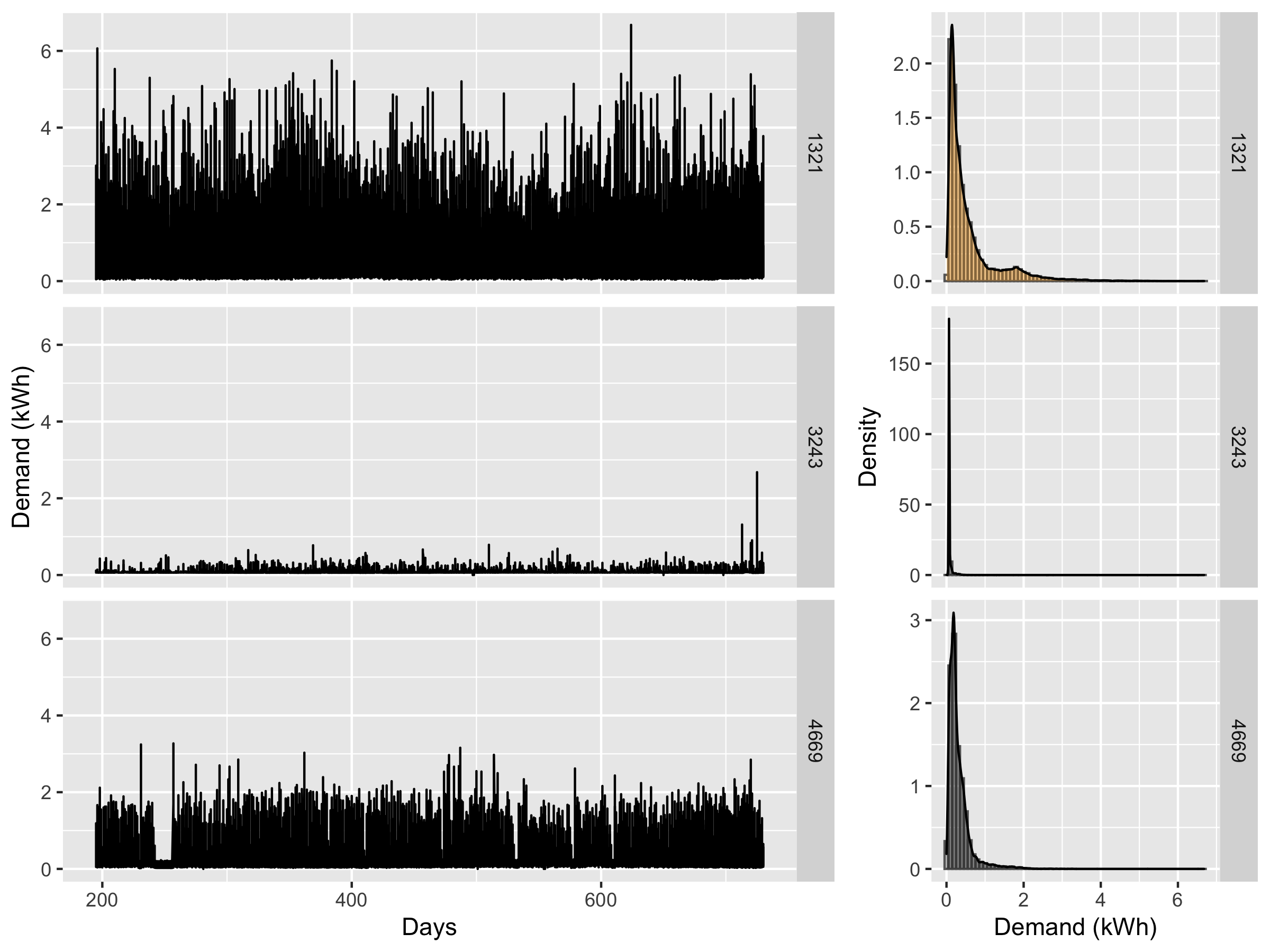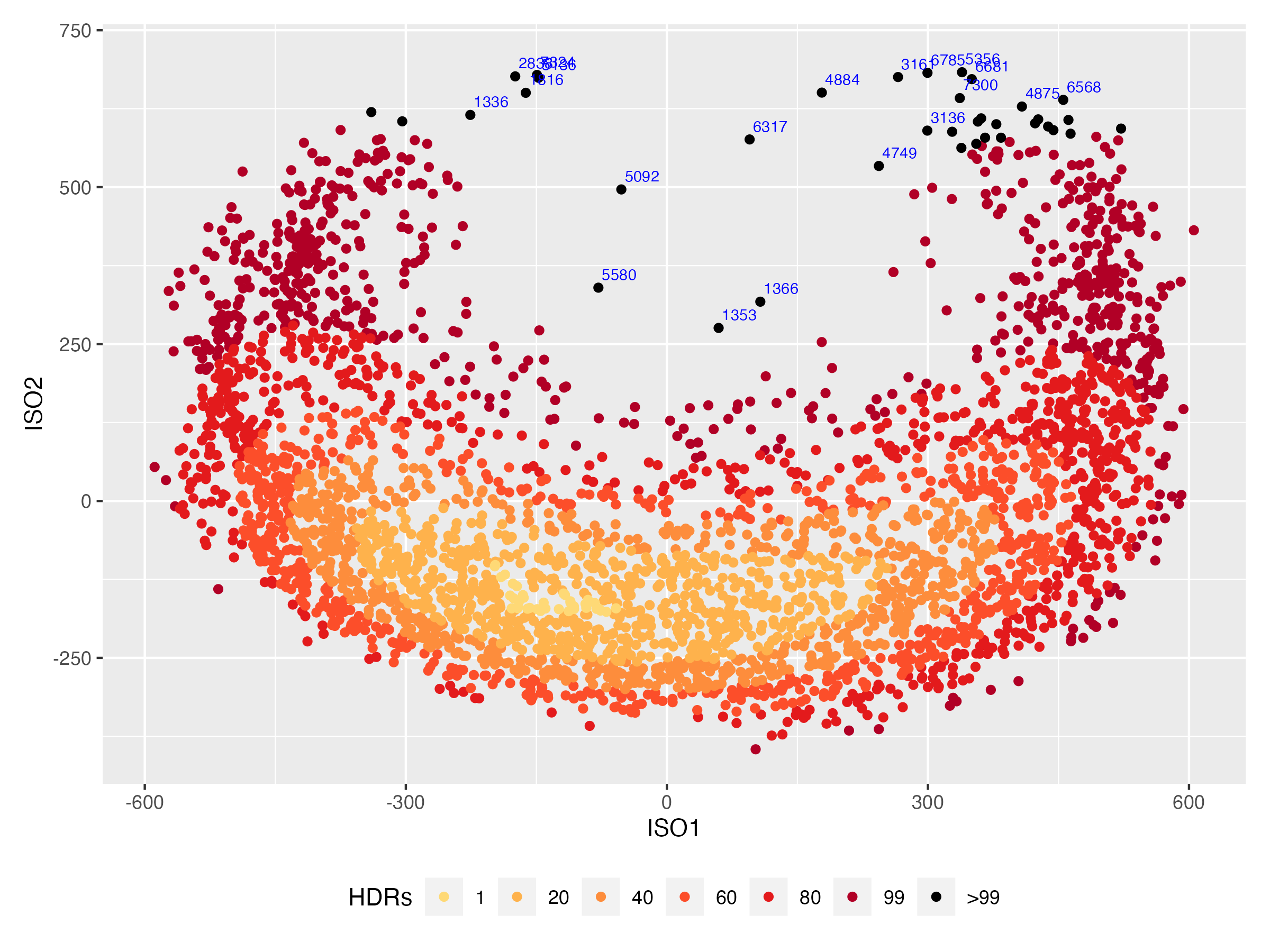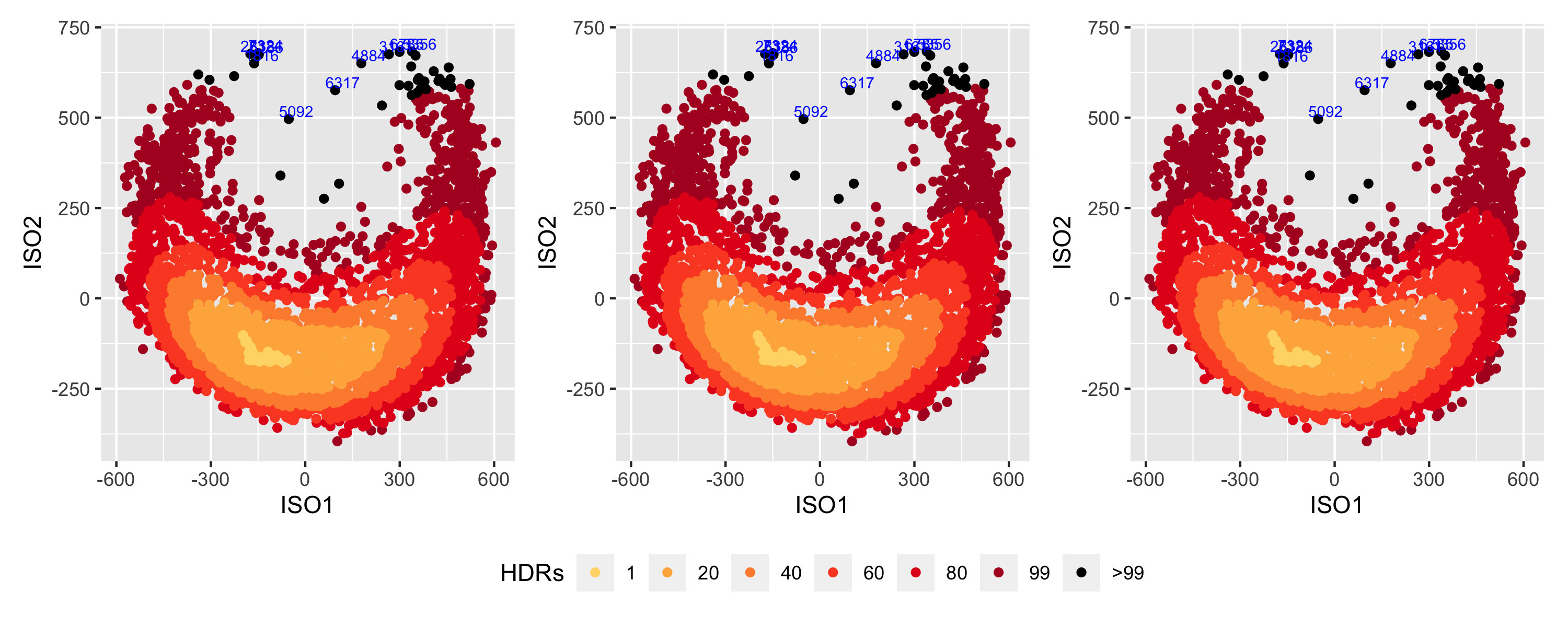Detecting anomalies
in smart meter data
via manifold learning
Anastasios Panagiotelis
University of Sydney
1
Smart Meter
- Smart meters measure electricity usage in a building.
- Need to detect anomalous electricity usage.
- Scalable to millions of buildings.

2
Smart Meter data
- Three housholds in an Irish dataset

3
Smart Meter data
- Interested in distribution

4
Visualisation

5
Interpretation
- Each dot represents the probability distribution of electricity usage for a single household.
6
Interpretation
- Each dot represents the probability distribution of electricity usage for a single household.
- The colors depend on the value of a kernel density estimate of the points.
6
Interpretation
- Each dot represents the probability distribution of electricity usage for a single household.
- The colors depend on the value of a kernel density estimate of the points.
- The 'typical' household comes from the middle of the distribution.
6
Interpretation
- Each dot represents the probability distribution of electricity usage for a single household.
- The colors depend on the value of a kernel density estimate of the points.
- The 'typical' household comes from the middle of the distribution.
- The 'anomalous' households comes from edges of the distribution.
6
Interpretation
- Each dot represents the probability distribution of electricity usage for a single household.
- The colors depend on the value of a kernel density estimate of the points.
- The 'typical' household comes from the middle of the distribution.
- The 'anomalous' households comes from edges of the distribution.
- But how do we get that plot?
6
Outline
- Manifold Learning
7
Outline
- Manifold Learning
- Multidimensional Scaling
7
Outline
- Manifold Learning
- Multidimensional Scaling
- Isomap algorithm
7
Outline
- Manifold Learning
- Multidimensional Scaling
- Isomap algorithm
- Statistical manifolds
7
Outline
- Manifold Learning
- Multidimensional Scaling
- Isomap algorithm
- Statistical manifolds
- Hellinger distance estimator
7
Outline
- Manifold Learning
- Multidimensional Scaling
- Isomap algorithm
- Statistical manifolds
- Hellinger distance estimator
- Why it is fast
7
Outline
- Manifold Learning
- Multidimensional Scaling
- Isomap algorithm
- Statistical manifolds
- Hellinger distance estimator
- Why it is fast
- Application
7
Outline
- Manifold Learning
- Multidimensional Scaling
- Isomap algorithm
- Statistical manifolds
- Hellinger distance estimator
- Why it is fast
- Application
- One household
7
Outline
- Manifold Learning
- Multidimensional Scaling
- Isomap algorithm
- Statistical manifolds
- Hellinger distance estimator
- Why it is fast
- Application
- One household
- All households
7
Dimension reduction
8
Idea
- Data are multivariate, i.e. xi∈Rp where p is large and i=1,2,…,n.
9
Idea
- Data are multivariate, i.e. xi∈Rp where p is large and i=1,2,…,n.
- Consider n firms with p financial indicators
9
Idea
- Data are multivariate, i.e. xi∈Rp where p is large and i=1,2,…,n.
- Consider n firms with p financial indicators
- Construct new data yi∈Rd where d<<p.
9
Idea
- Data are multivariate, i.e. xi∈Rp where p is large and i=1,2,…,n.
- Consider n firms with p financial indicators
- Construct new data yi∈Rd where d<<p.
- How might we do this?
9
Distances
- Close observations in input space should be close in output space.
10
Distances
- Close observations in input space should be close in output space.
- Euclidean distance is a measure of similarity.
10
Distances
- Close observations in input space should be close in output space.
- Euclidean distance is a measure of similarity.
- Inputs: δij=√(xi−xj)′(xi−xj)
10
Distances
- Close observations in input space should be close in output space.
- Euclidean distance is a measure of similarity.
- Inputs: δij=√(xi−xj)′(xi−xj)
- Outputs: dij=√(yi−yj)′(yi−yj)
10
Distances
- Close observations in input space should be close in output space.
- Euclidean distance is a measure of similarity.
- Inputs: δij=√(xi−xj)′(xi−xj)
- Outputs: dij=√(yi−yj)′(yi−yj)
- Construct y so that dij approximate δij
10
Criterion
Minimise:
∑i,j(δ2ij−d2ij)
Solved by
11
Criterion
Minimise:
∑i,j(δ2ij−d2ij)
Solved by
- Putting δij in a matrix Δ
- Double centering Δ
- Finding eigenvectors.
11
Non-Euclidean
- What if input distances δij are not Euclidean?
12
Non-Euclidean
- What if input distances δij are not Euclidean?
- Can put them in Δ anyway
12
Non-Euclidean
- What if input distances δij are not Euclidean?
- Can put them in Δ anyway
- Optimise a slightly different objective, but still get a good representation.
12
Non-Euclidean
- What if input distances δij are not Euclidean?
- Can put them in Δ anyway
- Optimise a slightly different objective, but still get a good representation.
- Output distances dij still approximate input distances δij
12
Manifold learning
- What if data lie on some non-linear d-dimensional surface in p-dimensional space.
13
Manifold learning
- What if data lie on some non-linear d-dimensional surface in p-dimensional space.
- Think of the surface of a sphere (2-dimensional) in space (3-dimensional).
13
Manifold learning
- What if data lie on some non-linear d-dimensional surface in p-dimensional space.
- Think of the surface of a sphere (2-dimensional) in space (3-dimensional).
- Euclidean distance is no longer appropriate
13
Manifold learning
- What if data lie on some non-linear d-dimensional surface in p-dimensional space.
- Think of the surface of a sphere (2-dimensional) in space (3-dimensional).
- Euclidean distance is no longer appropriate
- Should instead use the geodesic distance.
13
Manifold learning
- What if data lie on some non-linear d-dimensional surface in p-dimensional space.
- Think of the surface of a sphere (2-dimensional) in space (3-dimensional).
- Euclidean distance is no longer appropriate
- Should instead use the geodesic distance.
- This is the aim of ISOMAP.
13
Toy example
Consider the following data

14
Manifold
Lying on a manifold.

15
Euclidean distance
Blue points close in ambient space.

16
Geodesic Distance
But not on manifold.

17
Input distances
- Classical MDS would use the distance in blue as an input
18
Input distances
- Classical MDS would use the distance in blue as an input
- The idea behind Isomap is to use the distance in green as an input.
18
Input distances
- Classical MDS would use the distance in blue as an input
- The idea behind Isomap is to use the distance in green as an input.
- However to compute the geodesic (green) distance we need to know the manifold.
18
Input distances
- Classical MDS would use the distance in blue as an input
- The idea behind Isomap is to use the distance in green as an input.
- However to compute the geodesic (green) distance we need to know the manifold.
- Instead we approximate the geodesic distance
18
Geodesic Distance
Geodesic can be approximated.

19
Geodesic Distance
Try zooming.
20
Approximate Geodesic
- Find the graph of nearest neighbors
21
Approximate Geodesic
- Find the graph of nearest neighbors
- Neighbourhood within a ϵ-ball
- K-Nearest neighbours
21
Approximate Geodesic
- Find the graph of nearest neighbors
- Neighbourhood within a ϵ-ball
- K-Nearest neighbours
- As edge weights use the distance between neighbors
21
Approximate Geodesic
- Find the graph of nearest neighbors
- Neighbourhood within a ϵ-ball
- K-Nearest neighbours
- As edge weights use the distance between neighbors
- Approximate geodesic distance by finding shortest path
21
Example
- ISOMAP is just one manifold learning algorithm.
22
Example
- ISOMAP is just one manifold learning algorithm.
- Others include:
- LLE
- Laplacian Eigenmaps
- t-SNE
- ...
22
Example
- ISOMAP is just one manifold learning algorithm.
- Others include:
- LLE
- Laplacian Eigenmaps
- t-SNE
- ...
- These algorithms (and many others) use the nearest neighbor graph.
22
Statistical Manifolds
23
Statistical manifolds
- A statistical manifold is a manifold with elements that are probability distributions
24
Statistical manifolds
- A statistical manifold is a manifold with elements that are probability distributions
- Can no longer think of the inputs as being p-dimensional vectors
24
Statistical manifolds
- A statistical manifold is a manifold with elements that are probability distributions
- Can no longer think of the inputs as being p-dimensional vectors
- Can no longer think of Euclidean distance as being a distance between input points.
24
Statistical manifolds
- A statistical manifold is a manifold with elements that are probability distributions
- Can no longer think of the inputs as being p-dimensional vectors
- Can no longer think of Euclidean distance as being a distance between input points.
- We can use other measures of distance.
24
Hellinger Distance
- Distance between two distributions given by
H2i,j=12∫(√pi(z)−√pj(z))2dz
25
Hellinger Distance
- Distance between two distributions given by
H2i,j=12∫(√pi(z)−√pj(z))2dz
- Where pi(x) and pj(x) are densities corresponding to observation i and j respectively.
25
Hellinger Distance
- Distance between two distributions given by
H2i,j=12∫(√pi(z)−√pj(z))2dz
- Where pi(x) and pj(x) are densities corresponding to observation i and j respectively.
- Need to estimate using data zi,1,zi,2,…,zi,Ti∼pi and zj,1,zj,2,…,zj,Tj∼pj.
25
Our estimator
- Pool all the data zi,1,zi,2,…zi,Ti∀i=1,2,…,n together.
- Find L equal probability partitions of the pooled data Il=(γl−1,γl−1] and let
πi,l=√12Ti∑tI{zi,t∈Il}
26
Our estimator
- Pool all the data zi,1,zi,2,…zi,Ti∀i=1,2,…,n together.
- Find L equal probability partitions of the pooled data Il=(γl−1,γl−1] and let
πi,l=√12Ti∑tI{zi,t∈Il}
- Estimator is
^Hi,j=√∑l(πi,l−πj,l)2
26
Estimator
- We prove this estimator is consistent as the number of observations Ti and number of partitions L goes to infinity.
27
Estimator
- We prove this estimator is consistent as the number of observations Ti and number of partitions L goes to infinity.
- This is not the only estimator of Hellinger distance.
27
Estimator
- We prove this estimator is consistent as the number of observations Ti and number of partitions L goes to infinity.
- This is not the only estimator of Hellinger distance.
- What makes it special is that it 'looks like' a Euclidean distance.
27
Estimator
- We prove this estimator is consistent as the number of observations Ti and number of partitions L goes to infinity.
- This is not the only estimator of Hellinger distance.
- What makes it special is that it 'looks like' a Euclidean distance.
- This is important for computational reasons.
27
Nearest neighbour graph
- Recall that manifold learning algorithms require finding a nearest neighbor graph.
28
Nearest neighbour graph
- Recall that manifold learning algorithms require finding a nearest neighbor graph.
- A naive way to do this would be to compute all N2 pairwise distances.
28
Nearest neighbour graph
- Recall that manifold learning algorithms require finding a nearest neighbor graph.
- A naive way to do this would be to compute all N2 pairwise distances.
- A smarter way is to use an algorithm such as k-d trees.
28
Nearest neighbour graph
- Recall that manifold learning algorithms require finding a nearest neighbor graph.
- A naive way to do this would be to compute all N2 pairwise distances.
- A smarter way is to use an algorithm such as k-d trees.
- This only requires computing O(Nlog(N)) pairwise distances.
28
Nearest neighbour graph
- Recall that manifold learning algorithms require finding a nearest neighbor graph.
- A naive way to do this would be to compute all N2 pairwise distances.
- A smarter way is to use an algorithm such as k-d trees.
- This only requires computing O(Nlog(N)) pairwise distances.
- But it only works for a few distance metrics (one of which is Euclidean).
28
Approximate nearest neighbours
- Further speed up is possible via approximate nearest neighbors.
29
Approximate nearest neighbours
- Further speed up is possible via approximate nearest neighbors.
- May find an 'incorrect' nearest neighbor, but this is still guaranteed to be within 1+ϵ of the true nearest neighbor.
29
Approximate nearest neighbours
- Further speed up is possible via approximate nearest neighbors.
- May find an 'incorrect' nearest neighbor, but this is still guaranteed to be within 1+ϵ of the true nearest neighbor.
- We test for robustness of results to using ANN.
29
Approximate nearest neighbours
- Further speed up is possible via approximate nearest neighbors.
- May find an 'incorrect' nearest neighbor, but this is still guaranteed to be within 1+ϵ of the true nearest neighbor.
- We test for robustness of results to using ANN.
- We also use a more recent algorithm known as ANNOY
29
Application
30
Single household
- Consider a single household.
- Each 'observation' is the distribution corresponding to an hour of week, over many weeks.
- Here N=336 and T≈535
- Use ISOMAP with exact nearest neighbors, ANN and ANNOY
31
Results

32
Results

33
Typical and anomalous hours

34
Speed
| Isomap | LLE | Laplacian Eigenmaps | Hessian LLE | t-SNE | UMAP | |
|---|---|---|---|---|---|---|
| Exact NN with brute-force | 2.760 | 5.134 | 2.944 | 2.087 | 1.918 | 2.367 |
| Exact NN with k-d trees | 2.360 | 2.609 | 2.295 | 1.669 | 1.596 | 2.089 |
| ANN k-d trees | 2.351 | 2.986 | 2.302 | 1.663 | 1.601 | 2.048 |
| ANN Annoy | 1.942 | 3.093 | 2.378 | 1.695 | 1.647 | 2.125 |
35
Accuracy
| Isomap | LLE | Laplacian Eigenmaps | Hessian LLE | t-SNE | UMAP | |
|---|---|---|---|---|---|---|
| Exact NN | 0.943 | 0.709 | 0.885 | 0.882 | 0.935 | 0.924 |
| ANN k-d trees | 0.942 | 0.718 | 0.891 | 0.885 | 0.902 | 0.933 |
| ANN Annoy | 0.938 | 0.746 | 0.886 | 0.873 | 0.939 | 0.929 |
36
All households
- Consider all household.
- Each 'observation' is the distribution corresponding to an household.
- Here N=3639 and T≈179760
- Use ISOMAP with exact nearest neighbors, ANN and ANNOY
37
Results

38
Speed
| Isomap | LLE | Laplacian Eigenmaps | Hessian LLE | t-SNE | UMAP | |
|---|---|---|---|---|---|---|
| Exact NN with brute-force | 4773.4 | 4967.4 | 4725.2 | 5930.4 | 4739.6 | 748.6 |
| Exact NN with k-d trees | 755.8 | 1038.2 | 749.6 | 1204.1 | 747.7 | 744.3 |
| ANN k-d trees | 755.7 | 1041.0 | 751.5 | 1208.7 | 747.8 | 741.7 |
| ANN Annoy | 1670.2 | 1947.3 | 1656.1 | 2363.7 | 1557.1 | 1675.3 |
39
Accuracy
| Method | Isomap | LLE | Laplacian Eigenmaps | Hessian LLE | t-SNE | UMAP |
|---|---|---|---|---|---|---|
| Exact NN | 0.926 | 0.911 | 0.880 | 0.579 | 0.914 | 0.943 |
| ANN k-d trees | 0.926 | 0.911 | 0.880 | 0.579 | 0.919 | 0.943 |
| ANN Annoy | 0.926 | 0.911 | 0.880 | 0.578 | 0.907 | 0.943 |
40
Conclusions
- We have a way of visualising and finding anomalies for statistical manifolds
41
Conclusions
- We have a way of visualising and finding anomalies for statistical manifolds
- Relies on a consistent estimator of Hellinger distance
41
Conclusions
- We have a way of visualising and finding anomalies for statistical manifolds
- Relies on a consistent estimator of Hellinger distance
- Has computational advantages that exploit Nearest Neighbor algorithms
41
Conclusions
- We have a way of visualising and finding anomalies for statistical manifolds
- Relies on a consistent estimator of Hellinger distance
- Has computational advantages that exploit Nearest Neighbor algorithms
- Further computational improvements possible with ANN and there is little tradeoff on accuracy.
41
Questions?
42